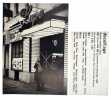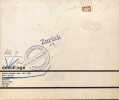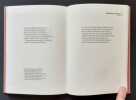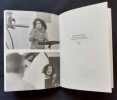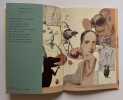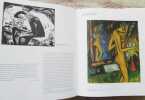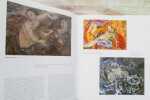1370 books for « wolf p de »Edit
-
Type
Book (1336)
Drawings (1)
Magazine (22)
Music sheets (11)
-
Latest
Last month (53)
Last week (10)
-
Language
Dutch (3)
English (6)
French (1314)
German (4)
Russian (43)
-
Century
16th (1)
17th (3)
18th (8)
19th (33)
20th (570)
21st (156)
-
Countries
Belgium (121)
Canada (3)
Côte d'Ivoire (3)
Denmark (13)
France (962)
Greece (1)
Italy (4)
Switzerland (216)
United Kingdom (5)
United States of America (42)
-
Syndicate
ALAC (3)
CLAM (8)
ILAB (590)
NVVA (67)
SLACES (67)
SLAM (442)
SNCAO (1)
Topics
- Alps (20)
- Alsace (39)
- Archaeology (16)
- Architecture (32)
- Army (51)
- Astronomy (4)
- Austria (4)
- Belgium (4)
- Bibliography (6)
- Biermann wolf (7)
- Biography (6)
- Botany (3)
- Children’s books (6)
- Children’s books (62)
- China (4)
- Civilisation (5)
- Comic strip (6)
- Contact sports (4)
- Contemporary look (4)
- Cooking (12)
- Culinary art (7)
- Dictionaries (3)
- Drawings (6)
- Dube wolf-dieter (6)
- Early printed books (8)
- Economics (5)
- Education (8)
- Education - morals (4)
- Egypt (7)
- English (6)
- Ethnology (5)
- Europe (4)
- Fantastic (4)
- Fashion (4)
- Fine arts (24)
- First edition (9)
- Geography (16)
- Germanic languages (61)
- Germany (19)
- Helvética (47)
- History (61)
- Hugo victor (15)
- Industrial arts & crafts - fine arts (10)
- Italian (4)
- Jacob (6)
- Jazz (4)
- Language (5)
- Lark (20)
- Law (6)
- Linguistics (6)
- Literature (142)
- Magazine (22)
- Manuscripts (4)
- Marseilles (5)
- Mathematics (4)
- Medicine (11)
- Military arts (5)
- Mountaineering climbing (13)
- Museums (3)
- Music (5)
- Navy (4)
- Newspaper (21)
- Newspapers press (26)
- Normandy (4)
- Oceania (3)
- Painters (11)
- Painting (9)
- Philology (7)
- Philosophy (8)
- Photography (31)
- Physics (6)
- Poetry (8)
- Policy (9)
- Psychology (3)
- Religions (8)
- Review (7)
- Reviews (24)
- Sciences (16)
- Scores (17)
- Scout (20)
- Sculpture (10)
- Sociology (7)
- Songs (12)
- Story (4)
- Sudan (3)
- Switzerland (32)
- Tales (9)
- Tea (8)
- Telephone - telegraph (3)
- Tiger (3)
- Topography (4)
- Town planning (6)
- Translation (4)
- Various (11)
- Viviane (3)
- Wagner richard (11)
- War (61)
- Wolf dieter (30)
- Youth (30)
- Zurich (4)
Hong Kong Whispers
, Hannibal Books, 2024 Hardcover, 160 pages, Illustrated, 25x19cm, Text in English. Fine . ISBN 9789464941203.
The posthumous release of the last book that Michael Wolf himself worked on, published to mark the fifth anniversary of his death Award-winning German photographer Michael Wolf (1954?2019) grew up in Canada, Europe and the United States. In 1994, Wolf moved to Hong Kong, where he worked for eight years as a contract photographer for Stern Magazine. The core of Wolf?s work consisted of capturing life in megacities. Many of his projects depict the architecture and popular culture of metropolises, and Hong Kong Whispers is no exception. This book contains a stunning series of photos showing the vibrant global city of Hong Kong. Wolf?s photographs are displayed in dialogue with the acerbic and ambiguous drawings of Arpaïs Du Bois (°1973). Based on intense engagement with Wolf?s series of images, she reflects on unnoticed moments and events that characterise life in the metropolis. The visual exchange between photographs and drawings took shape during Du Bois?s stay of several weeks in Hong Kong (2014), during which the two artists observed the city both together and individually.
Prolegomena ad Homerum sive de Operum Homericum prisca et genuina forma variisque mutationibus et probabili ratione emendandi. Volumen I (all that appeared). - [THE NEW PHILOLOGY - PMM 248]
Halis Saxonum (Halle), E Libreria Orphanotrophei, 1795. 8vo. Contemporary half calf with a bit of wear, especially to corners and edges. Gilding to title-label worn off. Paper over boards loosening at edges. Overall fine and tight. A light damp stain to upper margin and a few leaves with some light brownspotting.
Scarce first edition of the epoch-making work that founded modern philological scholarship and began the modern debate over the date of writing of Homer's works, creating in turn the two Homeric schools of thought, the Analysts and the Unitarians. Although the work bears on the title-page the words ""Volumen I"", no second volume ever appeared, and Wolf never made any attempt to compose it. ""When Wolf took up his professorship in 1783, a critical point in the history of education had been reached. New ideas derived from Locke and Rousseau were at work and Wolf longed to enter the fray. He found able and enlightened allies in the ministers of Frederick the Great, and with their help and by his enthusiasm he was able to carry out his long-cherished plan to give a new basis to the science of philology. To Wolf this meant philology in the original sense - love of letters, of learning and of language. He defined it as ""the knowledge of human nature as exhibited in antiquity"""" its matter was everything that remained of ancient culture, to which an equal care and scholarship must be devoted. The ""Prolegomena to Homer"", the best exposition of Wolf's beliefs, were written in a great hurry to meet the needs of a lecture course, and they have all the merits of good lectures: command of method, the gift of inspiration, penetration and breadth of view. Wolf's thesis is no theory, but a collection of great ideas, which laid the foundations for the dominance of German scholarship in the nineteenth century. They have inspired and given purpose to education ever since."" (Printing and the Mind of Man).With the 18th century came major developments in classical scholarship, the greatest of the classic epics being no exception - Homeric scholarship changed dramatically, and the end of the century saw the opening of the discussion which was to dominate the 19th and 20th centuries, namely that of the ""Homeric question"". The Homeric question is essentially the question of the identity of the poet(s) of the Homeric epics, and the nature of the relationship between ""Homer"" and the epics. In the 19th century it came to be the fulcrum between two opposed schools of thought, the Analysts and the Unitarians. The issue came about in the context of 18th-century Romantic interest in popular lays and folktale, and the growing recognition that the Homeric epics must have been transmitted orally before being written down, possibly much later than ""Homer"" himself. The key to determining who Homer was, lay in the answer to the question of when the poems were composed.The modern debate over exactly when they took on a fixed written form, began with the present work by Wolf. According to Wolf, the date of writing is among the first questions in the textual criticism of Homer. He considers the real mode of transmission of the poems and acknowledges that it was oral, arguing that they were composed in the mid-10th century BC. He further concludes that the Iliad and the Odyssey could not have been composed in the form in which we know them without the aid of writing and that they changed considerably over time in the hands of bards performing them orally and editors adapting written versions to contemporary tastes. The apparent artistic unity of the poems must have come about after their transcription.This new form of philological scholarship completely altered the way that philology has been done ever since the appearance of the present work.
Prolegomena ad Homerum sive de Operum Homericum prisca et genuina forma variisque mutationibus et probabili ratione emendandi. Volumen I (all that appeared). - [THE NEW PHILOLOGY - PMM 248]
Halis Saxonum (Halle), E Libreria Orphanotrophei, 1795. 8vo. Contemporary half calf with five raised bands and gilt title-and tome-labels. Very neatly rebacked. Very nice and clean. An excellent copy. (6), CCLXXX pp.
Scarce first edition of the epoch-making work that founded modern philological scholarship and began the modern debate over the date of writing of Homer's works, creating in turn the two Homeric schools of thought, the Analysts and the Unitarians. Although the work bears on the title-page the words ""Volumen I"", no second volume ever appeared, and Wolf never made any attempt to compose it. ""When Wolf took up his professorship in 1783, a critical point in the history of education had been reached. New ideas derived from Locke and Rousseau were at work and Wolf longed to enter the fray. He found able and enlightened allies in the ministers of Frederick the Great, and with their help and by his enthusiasm he was able to carry out his long-cherished plan to give a new basis to the science of philology. To Wolf this meant philology in the original sense - love of letters, of learning and of language. He defined it as ""the knowledge of human nature as exhibited in antiquity"""" its matter was everything that remained of ancient culture, to which an equal care and scholarship must be devoted. The ""Prolegomena to Homer"", the best exposition of Wolf's beliefs, were written in a great hurry to meet the needs of a lecture course, and they have all the merits of good lectures: command of method, the gift of inspiration, penetration and breadth of view. Wolf's thesis is no theory, but a collection of great ideas, which laid the foundations for the dominance of German scholarship in the nineteenth century. They have inspired and given purpose to education ever since."" (Printing and the Mind of Man).With the 18th century came major developments in classical scholarship, the greatest of the classic epics being no exception - Homeric scholarship changed dramatically, and the end of the century saw the opening of the discussion which was to dominate the 19th and 20th centuries, namely that of the ""Homeric question"". The Homeric question is essentially the question of the identity of the poet(s) of the Homeric epics, and the nature of the relationship between ""Homer"" and the epics. In the 19th century it came to be the fulcrum between two opposed schools of thought, the Analysts and the Unitarians. The issue came about in the context of 18th-century Romantic interest in popular lays and folktale, and the growing recognition that the Homeric epics must have been transmitted orally before being written down, possibly much later than ""Homer"" himself. The key to determining who Homer was, lay in the answer to the question of when the poems were composed.The modern debate over exactly when they took on a fixed written form, began with the present work by Wolf. According to Wolf, the date of writing is among the first questions in the textual criticism of Homer. He considers the real mode of transmission of the poems and acknowledges that it was oral, arguing that they were composed in the mid-10th century BC. He further concludes that the Iliad and the Odyssey could not have been composed in the form in which we know them without the aid of writing and that they changed considerably over time in the hands of bards performing them orally and editors adapting written versions to contemporary tastes. The apparent artistic unity of the poems must have come about after their transcription.This new form of philological scholarship completely altered the way that philology has been done ever since the appearance of the present work.
HUNTER, (William) ; WOLF, (Johann Christoph) & ESCHELSKROON, (Adolph).
Reference : 4964
(1793)
I. Description du Pegu et de l'Isle de Ceylan. Renfermant des détails exacts et neufs sur le climat, les productions, le Commerce, le Gouvernement, les Moeurs et les Usages de ces Contrées. Traduit de l'Anglois & de l'Allemand par L.L.***. II. La vie et les aventures de Jean-Christophe Wolf, premier secrétaire d'Etat à Jaffanapatnam dans l'isle de Ceylan avec description de cette isle, de ses productions naturelles, des manières et des usages de ses habitans. Traduites de l'allemand. On y a joint une description abrégée mais complette de la mème isle.
Paris, Maradan, 1793. 1793 1 vol. in-8° (200 x 128 mm.) en 2 parties avec pagination continue de: partie 1: 32 pp. (dont faux titre, titre); 95 pp.; partie 2: [2] ff. (faux titre, titre); 354 pp. (dont table, reprise de la pagination à 97, sauts et erreurs dans la pagination sans manque, 351 pp. en réalité). Ex-libris armorié gravé collé au dos du premier plat: «Bibliothèque de Mr. Le Baron de Zangiacomi». (Quelques mouillures, rousseurs et marques dues au cuir). Demi-basane à coins dépoque, plats recouverts de papier à la colle fauve, dos à nerfs ornés, titres de maroquin rouge et vert, tranches jaspées de bleu. (Défauts dusage).
Edition originale des traductions en français par Louis Langlès de cette réunion de 3 travaux réunis en 2 parties sur Pégu, ville portuaire du sud de la Birmanie, et le Ceylan, Sri Lanka actuel (E.O. : I. Londres, 1785, II. Berlin & Stettin, 1782 et Hambourg, 1782). William Hunter (1718-1783), médecin, professeur, anatomiste et orientaliste écossais, vécut une grande partie de sa vie en Inde. Après avoir choisi de faire une maîtrise en arts à l'Université de Glasgow, qui le mènerait à une carrière religieuse, il vient à la médecine en étudiant avec William Cullen (1710-1790 ; médecin et chimiste britannique). Il commence à s'intéresser à l'anatomie au St George's Hospital de Londres, se spécialise dans l'obstétrique et arrive à établir ce domaine comme une branche à part entière et acceptée de la médecine. Après 1756, la pratique médicale de Hunter était principalement consacrée à l'obstétrique, et il était le spécialiste le plus performant dans ce domaine en Grande-Bretagne à son époque, devenant médecin de la reine Charlotte en 1762. Il est élu membre de la Royal Society en 1767 et professeur d'anatomie à la Royal Academy en 1768. Pour aider à l'enseignement de la dissection, il engage le sculpteur Agostino Carlini (vers 1718-1790; sculpteur, peintre et membre fondateur de la Royal Academy) pour faire des sculptures des écorchés d'un criminel récemment exécuté. Il est très intéressé par l'art et a de vastes connexions avec le monde artistique. Hunter choisit pour illustrer ses schémas les dessins de Léonard de Vinci (1452-1519 ; célébrissime peintre italien et homme d'esprit universel) et Kenneth Clark (1903-1983 ; historien de l'art, auteur, directeur de musée, professeur d'université) le considère comme la personne qui a permis la redécouverte des dessins de Léonard de Vinci au XVIIIe siècle au Royaume-Uni. En outre, Hunter est un collectionneur de minéraux, monnaies, instruments scientifiques, objets ethnographiques, de livres rares et d'uvres d'art en tout genre. Il a légué ses collections à l'université de Glasgow, un acte qui a inspiré l'ouverture du Hunterian Museum, le premier musée public d'Écosse, en 1807. Dans les dernières années de sa vie, Hunter prend le poste de chirurgien sur un vaisseau de marine avant de passer au service de la Compagnie des Indes dans le Bengale. Il est envoyé à Java comme inspecteur général des hôpitaux, professeur et examinateur du collège de Calcutta et enfin, secrétaire de la Société asiatique. Hunter a rassemblé les matériaux pour la première partie du présent ouvrage en juillet 1782, lorsque son navire a été retenu par une tempête à Pegu. Il décrit les produits et l'agriculture de Pegu, ainsi que les grottes d'Elephanta, d'Ambola et de Canara. Cette partie est complétée par un important compte rendu de Ceylan, le tout traduit de langlais (E.O. : Londres, 1785). La seconde partie intitulée "La vie et les avantures de Jean-Christophe Wolf [...] (pp. 96-354), traduit de lallemand (E.O. : Berlin & Stettin, 1782) est due à Wolf lui-même, relate ses aventures à Ceylan. Johann Christoph Wolf (1683-1739) est un savant, hébraïste allemand, professeur de langues orientales à Hambourg, recteur de l'académie de cette même ville et premier secrétaire d'État à Jaffanapatnam à Ceylan. Suit la traduction de lallemand en français (E.O. : Hambourg, 1782) de la description abrégée de cette île due à Adolf Eschelskroon (1736-1793), explorateur danois, marchand, consul et agent royal danois à Kiel qui vécut aux Indes orientales pendant 18 ans. Provenance : le Baron Zangiacomi (1766-1846), magistrat et un homme politique français : il est successivement pair de France, président de chambre et conseiller à la Cour de cassation, membre du Conseil des Cinq-Cents et député de la Convention nationale (ex-libris armorié gravé collé au dos du premier plat). Rare édition en français dont on ne dénombre que quelques exemplaires passés en vente ces 100 dernières années. 1 vol. 8vo (200 x 128 mm.) in 2 parts with continuous pagination of : part 1 : 32 pp. (of which false title, title) ; 95 pp. ; part 2 : [2] ff. (false title, title); 354 pp. (including table, resumption of pagination at 97, jumps and errors in pagination without incidence, 351 pp. in reality). Engraved armorial bookplate pasted to the back cover: "Bibliothèque de Mr. Le Baron de Zangiacomi". (Some spotting, foxing and marks due to the leather). Contemporary half-basane with corners, boards covered with glue paper, spine ribbed and decorated, titles in red and green morocco, edges speckled with blue. (Defects of use). First edition of the French translations by Louis Langlès of this collection of 3 works in 2 parts on Pegu, a port city in southern Burma, and Ceylon, present-day Sri Lanka (E.O.: I. London, 1785, II. Berlin & Stettin, 1782 and Hamburg, 1782). William Hunter (1718-1783), a Scottish physician, teacher, anatomist and orientalist, lived much of his life in India. After choosing to pursue a Master of Arts degree at Glasgow University, which would lead to a religious career, he came to medicine by studying with William Cullen (1710-1790; British physician and chemist). He became interested in anatomy at St. George's Hospital in London, specialized in obstetrics, and succeeded in establishing this field as a separate and accepted branch of medicine. After 1756, Hunter's medical practice was primarily devoted to obstetrics, and he was the most successful specialist in this field in Britain in his day, becoming physician to Queen Charlotte in 1762. He was elected a Fellow of the Royal Society in 1767 and Professor of Anatomy at the Royal Academy in 1768. To help teach dissection, he hired the sculptor Agostino Carlini (c. 1718-1790; sculptor, painter and founding member of the Royal Academy) to make sculptures of the flayed body of a recently executed criminal. He was very interested in art and had extensive connections to the art world. Hunter chooses to illustrate his diagrams with the drawings of Leonardo da Vinci (1452-1519; celebrated Italian painter and universal mind) and Kenneth Clark (1903-1983; art historian, author, museum director, university professor) considers him the person who brought about the rediscovery of da Vinci's 18th century drawings in the UK. In addition, Hunter is a collector of minerals, coins, scientific instruments, ethnographic objects, rare books and works of art of all kinds. He bequeathed his collections to the University of Glasgow, an act that inspired the opening of the Hunterian Museum, the first public museum in Scotland, in 1807. In the last years of his life, Hunter took the position of surgeon on a naval vessel before moving to the service of the India Company in Bengal. He was sent to Java as Inspector General of Hospitals, Professor and Examiner of the College of Calcutta and finally, Secretary of the Asiatic Society. Hunter gathered the materials for the first part of this work in July 1782, when his ship was held up by a storm at Pegu. He describes the produce and agriculture of Pegu, as well as the caves of Elephanta, Ambola, and Canara. This part is completed by an important account of Ceylon, all translated from English (E.O.: London, 1785). The second part, entitled "The life and adventures of Johann Christoph Wolf [...]" (translated from French, pp. 96-354), translated from the German (E.O.: Berlin & Stettin, 1782), is due to Wolf himself and relates his adventures in Ceylon. Johann Christoph Wolf (1683-1739) was a German scholar, Hebraist, professor of Oriental languages in Hamburg, rector of the academy of the same city and first secretary of state in Jaffanapatnam in Ceylon. Follows the translation from German into French (E.O.: Hamburg, 1782) of the abridged description of this island due to Adolf Eschelskroon (1736-1793), Danish explorer, merchant, consul and royal Danish agent in Kiel who lived in the East Indies for 18 years. Provenance: Baron Zangiacomi (1766-1846), a French magistrate and politician: he was successively peer of France, president of chamber and adviser to the Court of Cassation, member of the Council of Five Hundred and deputy of the National Convention (armorial bookplate engraved pasted on the back of the first plate). Rare edition in French of which only a few copies have been sold in the last 100 years.
1) Rudolf Wolfs Jugendtagebuch 1835-1841. / 2) JAEGGLI, Alvin: Die Berufung des Astronomen Joh. Rudolf Wolf nach Zürich 1855. (1968) / 3) Professor Rudolf Wolf und seine Zeit. 1816-1893. 5 Zus.
Zürich, ETH-Bibliothek 1993 1993 - in-4to, 129 S. mit Abb. / 30 S. m. Abb. / 6 Bl. (Abb.) + 57 Bl. (recto’s leer) + Mitgl.-Karte in die Rudolf Wolf gesellschaft, Hlwd.
Rudolf Wolf (1816-1893), Astronomiker, Forschungsorganisator und Wissenschaftshistoriker. Dazu 4) Paul Wild: Ergebnisse der Himmelsüberwachung in Zimmerwald Diss. 1974, 24 Bl. / 5) Reden gehalten bei der Trauerfeierlichkeiten für Herrn Dr. J. Rudolf Wolf am 9 Dezember 1893. 15 S. + 1 leer

(SLACES, NVVA)
Phone number : 41 (0)26 3223808
[Griffith P.M ] - Wolf Rube - Wolf Rube,Merrick Billy - Wolf Rube,Merrick Billy
Reference : 108628
(1927)
Partition de la chanson : Do you love me ? ( When skies are gray )
Sherman Clay and Co. San Francisco 1927
Bon état Format Américain Piano,Ukulélé
Psychologie ou traité sur l'ame, contenant les connoissances que nous en donne l'experience
Chez Pierre Mortier | 1745 | 10 x 17 cm | relié
Édition originale française, après l'originale allemande parue en 1732 sous le titre: Psychologia empirica. Reliure en pleine basane brune d'époque. Dos à nerfs orné. Pièce de titre en maroquin rouge. Un manque en tête, idem manques en queue. Mors fendus en tête et en queue. Coins émoussés. Page de titre avec brunissures dans les marges. Wolf a cherché a redéfinir l'ensemble de la philosophie à partir d'un principe de connaissance stable fondé sur la déduction et le modèle de la géométrie; rationaliste, c'est un disciple de Leibniz auquel il emprunte nombre de concepts. Et cependant pour la première fois dans l'histoire de la philosophie, Wolf confère une autonomie à la psychologie qu'elle n'avait jamais eue auparavant, distinguant une psychologie rationnelle et une psychologie empirique (le traducteur ayant choisi le terme de psychologie expérimentale qui sera promu à un grand avenir en France). En outre Wolf a parfait la question du symbolisme et de la relation du corps au signe et à la représentation. Le traducteur, face à l'oeuvre incroyablement prolixe de Wolf et aux médiocres abrégés qu'il a rencontrés, a préféré suivre pas à pas l'auteur dans la construction de ses idées et de ses thèses sans en donner une traduction exhaustive et littérale peu lisible. Ex-libris aux armes du XVIIIème non identifiées. - Photographies et détails sur www.Edition-Originale.com -


Phone number : 01 56 08 08 85
LES CHERCHEURS DE TRESOR OU LES VRAIS WOLFISTES. Un trésor est caché dedans avec WOLF vous le trouverez.
Wolf SD (vers 1950 Wolf SD (vers 1950), plaquette In-8 broché, 96 pages. Dessins, photos. Rousseurs au deuxième plat.
Plaquette publicitaire avec de nombreux conseils de jardinage publiée par la marque d'outillage de jardin WOLF. Toutes les expéditions sont faites en suivi au-dessus de 25 euros. Expédition quotidienne pour les envois simples, suivis, recommandés ou Colissimo.
QUINTETT FUR PIANOFORTE ZWEI VIOLINEN, VIOLA UND VIOLONCELL COMPONIRT VON E. WOLF FERRARI OP. 6
LEIPZIG D. RAHTER LEIPZIG 1901
Edizione del 1901 della melodia "Quintetto" dall'opera 6 del compositore e pianista Ermanno Wolf Ferrari (1876-1948). Partitura per quintetto: pianoforte, Violoncello n. 1, violino n. 1 e n. 2, viola n. 1. In discrete condizioni. Copertina editoriale in buone condizioni con usure marginali. Legatura editorialmente assente. Pagine in buone condizioni con rare fioriture. In Folio. cm. 34,5x27,5. Pp. 11+11+11+11+59.Edition of 1901 of the melody "Quintetto" from the opera 6 by the composer Ermanno Wolf Ferrari (1876-1948). Scores for quintett: piano, Violoncello n. 1, violin n. 1 e n. 2, viola n. 1. In fair conditions. Editorial cover in poor conditions lightly worn in the extremities. Binding editorially missing. Pages in good conditions with occasional foxing. In Folio. cm. 34,5x27,5. Pp. 11+11+11+11+59.
Wolf Vostell, Georges Brecht, Joseph Beuys, Stanley Brouwn, Allan Kaprow, Higgins, Paik, Jean Jacques Lebel, Tomas Schmit, Claes Oldenburg, Al Hansen, C. Caspari, Christo, Jed Curtis, Henry Flint, Gyogy Ligetti, Nam June Paik, Jan Voss, Vostell, F.Mon, Pera, F.Trowbridge, J.P.Wilhelm
Reference : 105480
DE-COLL/AGE 1-7Collection complète "Bulletin actueller Ideen", puis "Bulletin der fluxus und happening avant-garde"
Fondée et dirigée par l’artiste et graphiste Wolf Vostell à l’intersection des tendances avant-gardistes des années 60, entre néo-dada, nouveau réalisme, happening, pop-art et actionnisme.
dé-coll/age 1 : Juin 1962.Arthur Köpcke, George Maciunas, Benjamin Patterson, Nam June Paik, La Monte Young, Volf Vostell and others. (28) pp en 7 doubles pages dépliantes sous couverture imprimée, bande-annonce, annotation en couverture, partie de timbre et cachet postal au dos.dé-coll/age 2 : Novembre 1962Réalisé par Dick Higgins. 21 pages ronéotées et agrafées, couverture en papier, bulletin de souscription.dé-coll/age 3: Dec 1962Köln, 270x218mm, décembre 1962, (108) + (12) pp., dont une page transparente et plusieurs dépliantes, agrafé, couverture muette, jaquette imprimée.Contributions de C. Caspari, Christo, Jed Curtis, Henry Flint, Dick Higgins, Gyogy Ligetti, Nam June Paik, Jan Voss, Vostell, F.Mon, Pera, F.Trowbridge, J.P.Wilhelm. Divers types d’impression : offset, ronéo, sérigraphie. Nombreuses illustrations avec pages dépliantes.dé-coll/age 4: Janvier 1964Spécial HappeningsGeorges Brecht, Stanley Brouwn (sac en papier tamponné collé sur une des pages), Allan Kaprow, Higgins, Paik, Jean Jacques Lebel, Tomas Schmit, Claes Oldenburg, Al Hansen and others. (132) pp en 33 doubles pages dépliantes + (23) pp. Couvertures en papier, jaquette. Complet du « Brouwn Bag », le multiple original de Stanley Brouwn.dé-coll/age 5: Février 1966Happenings/Stücke/PartiturenEdition de 500 exemplaires (n°379). 22 éléments-multiples contenus dans un portefeuille.Premier multiple de Joseph Beuys: "Zwei Fraulen mit lenchtendem Brot" consistant en un bloc de chocolat fixé sur une bande de papier imprimé. (Schellmann, Joseph Beuys Multiples n°2.)Participations de René Block, Claus Bremer, Ludwig Gosewitz, Dick Higgins, Allan Kaprow, Patterson, Ben Vautier et les membres du groupe Zaj. au portfolio.dé-coll/age 6Cologne, Wolf Vostell, juillet 1967; 290x217mm, non paginé (174), agrafé sous couverture illustrée.Textes en allemand et anglais. Participations de Higgins, Maciunas, Vostell, Gustav Metzger, Milan Knizac, Vautier, Hansen, Kaprow, Paik, Franz Mon, Daniel Spoerri, Charlotte Moorman, Lebel, Alison Knowles.Complet du multiple original de Diter Rot « das Blaue Geheul » glissé dans la pagination. Couvertures cartonnées (la première reproduit la une du Figaro du 6 septembre 1954), agrafé. dé-coll/age 7 ELEKTRONISCHER dé-coll/age HAPPENING RAUM 1959-1968Février 1969, 94 pages imprimées dur une seule face et reliées en un volume broché 191x191mm, couverture imprimée Tirage de 500 ex.Contributions de Friedruch Wolfram Heubach, Peter Saage, Wolf Vostell. Annotations en page de titre.Quelques défauts minimes, très bon état général malgré queslaus rousseurs.Sohm p.111 n°176, reproduit ; Marie Boivent Revues d’Artistes : une sélection p. 24-27 ; In Numbers p.138 à 145. Schellmann, Joseph Beuys Multiples n°2 (2816.11) (105480)
Phone number : +33 1 48 01 02 37
Wolf Vostell, environnement, vidéo, peintures, dessins, 1977 – 1985.
Strasbourg, Musée d’art moderne, 1985. In-4 br., couverture illustrée à système, 87 pp. Catalogue conçu par Nadine Lehni et Wolf Vostell. Complet du livret découpé à l’angle supérieur droit (Notes sur ma musique). On joint un dépliant de l’installation vidéo Dépression endogène à l’Espace 251 Nord de Liège avec salutations manuscrites. Un coin un peu enfoncé, sinon bon état.
Co-fondateur du groupe Fluxus avec Nam June Paik et George Maciunas en 1962, Wolf Vostell (1932-1998), a été l’un des premiers artistes à expérimenter l’installation, le happening ou l’art vidéo. Réinventeur de la formule Art = Vie, il a pratiqué le décollage, le balayage pictural, la sculpture, le déréglage et le parasitage électroniques, l’encastrement dans le béton, le détournement des grands fleurons de l’industrie et de la consommation.
Volch'e solntse. In Russian /Wolf Sun
Short description: In Russian. Ehrlich, Wolf. Wolf sun. Leningrad: Priboy, 1928: typo-lit. Bulletin of the Leningrad Soviet. Please feel free to contact us for a detailed description of the copies available. SKU9254671
Maschinengeschriebener, signierter und datierter Brief an Bernhard Höke auf einer Fotokopie und 6 maschinengeschriebene, datierte und signierte Blätter.
total 7 Blatt. Köln, 20. Oktober 1966. 21,5 x 30,5 cm.
Wichtiger Brief und Dokumente zur Zusammenarbeit zwischen Vostell und der edition et. Er bittet um Bestätigung der gemeinsam in Berlin besprochenen Projekte, die er gerne fixiert hätte. "ich hoffe auch, dass der liebe gruetzmacher finanziell bei der stange bleibt, denn gerade bei intensiver herausgabe von buechern muss er wenigsten fuer die herausgeber vorschuesse zahlen und natuerlich fuer die autoren bei der herausgabe erst so macht es rowohlt auch." Vostell will "mehr noch als vorher" nach Berlin ziehen. Block hat schon eine neue Galerie gefunden, jetzt braucht es nur noch einen Geldgeber für das grosse Berliner Avantgardefestival zu finanzieren. "Obwohl ich manches Bild verkaufe reicht es hinten und vorne nicht - ich vermute die zukunft wird nicht leicht werden". Vostell bietet sich der edition et als Herausgeber von 6 Publikationen an: 1: Architektur. Das Enviroment von Malern und Musikern "mit Beiträgen von Bazon Brock, Yves Klein, Diter Rot, Gerhard Rühm, Nam June Paik, Dick Higgins etc." Die Publikation erschien dann 1969 in Deutsch im Droste Verlag unter dem Titel "Pop Architektur" und noch im gleichen Jahr als "Fantastic Architecture" in der Something Else Press. 2: Frohe Weihnachten. Ein Objektbuch von P. O. Chotjewitz und Wolf Vostell. Mit 2 Vostellverwischungen, 3 Chojewitztexten", Auflage 300 Exemplare. - Das Projekt wurde nie realisiert. 3: Dé-Coll/age Happenings. Mit Texten von Vostell. Erscheinungstermin 1967 oder 1968. Der Band wurde schliesslich 1970 von Rowohlt als "Aktionen - Happenings und Demonstrationen seit 1965" realisiert. 4: Woerterbuch 1. Ein gesamtdeutsches woerterbuch ueber das wort "SCHOEN". Viele wiederspruchsvolle (sic) und zerstrittene Leute erklären und schreiben nieder was fuer sie SCHOEN ist oder unter dem Wort verstanden wird. Politiker, Funktionaere, Buergermeister, Kuenstler, Musiker, Maurer, Millionaere etc." - Das Projekt blieb unrealisiert. 5: "statt architektur". Mein 3. Beitrag fuer edition et 3. - Wurde nicht realisiert. 6: Spielpläne 1. Herausgegeben von Bernhard Hoeke und Wolf Vostell. Liste der Autoren: Bazon Brock, Peter Otto Chotjewitz (gestrichen), Bernhard Hoeke, Wolf Vostell, Vagelis Tsakiridis, Diter Rot, Gerhard Rühm, Ludwig Gosewitz, Nam June Paik, Dick Higgins, Alison Knowles, Emmett Williams, Allan Kaprow, Claes Oldenburg, Al Hansen, Ben Vautier, George Maciunas, Milan Knisak, Jean Jaques Lebel. "ich kenne alle autoren persoenlich und koennte sie anschreiben". Mit einer Liste seiner eigenen, für die Anthologie vorgesehenen Texte. Die Anthologie ist nie erschienen. Bernhard Höke 'übernahm' das Projekt, das bis zum Fahnenabzug gelangte, jedoch nie in den Druck ging. Bisher unveröffentlicht.
Italienisches Liederbuch - Michelangelo Lieder -
49 lieder enregistrés par Angelika Kirchschlager (mezzo-soprano), Florian Boesch (baryton-basse) et Malcom Martineau (piano) : poèmes de Paul Heyse traduits de l'allemand (texte original en regard de la traduction) par Fréfédic Wandelère. Essais de Stéphane Godet, Florian Rodari et Frédéric Wandelère. Genève : La Dogana (Collection "Ad alta voce"), 2014 - Un volume 14,5x20cm cartonné de 158 pages (textes en allemand avec la traduction en regard), contenant un CD de 78'14'' enregistré à Vienne en 2013 - état neuf -
Lieder en forme de vignettes forment l’Italienisches Liederbuch, la dernière contribution importante de Hugo Wolf (1860-1903) à la forme du lied avant sa mort trop tôt venue. Le compositeur puise son inspiration dans un recueil de brefs poèmes amoureux, rispetti et vilote italiens, traduits en 1860 par l’écrivain Paul Heyse (Prix Nobel de littérature 1910). Dans ce cycle inspiré par les amours de très jeunes gens, tous les registres du sentiment sont exprimés en quelques mesures : respect, aveux timides, admiration béate, extase, attente, désir, inquiétude, jalousie, piques, moquerie, colère, chagrin, réconciliations. Wolf excelle dans cette description de l’âme adolescente en proie aux premiers troubles de l’amour. En témoigne cette déclaration tirée d’une lettre datée de 1891 : « Mes chants italiens sont ce que j’ai fait de plus original et de plus parfait artistiquement. » Angelika Kirchschlager et Florian Boesch mettent au service de ces tableaux vifs et variés leur connaissance intime de l’art du lied. Dans ce CD de plus d’une heure, enregistré en studio à Vienne, ils sont accompagnés par le pianiste anglais Malcolm Martineau dont l’interprétation d’une rare subtilité confère une unité souveraine à l’ouvrage. Les textes en allemand et leur traduction par Frédéric Wandelère sont commentés dans les pages du livre par des essais de Stéphane Goldet, auteur d’une biographie consacrée à Hugo Wolf (Fayard, 2003), Florian Rodari et Frédéric Wandelère. (présentation de l'éditeur)
They Say -
1993 Berkeley - Arne Wolf - 1993 - 1 volume plié en accordéon illustré en bleu avec texte en rouge - couverture illustrée -
Livre d'artiste: "This copy is no AP4/4 in an édition of 30" - Très bel ouvrage en parfait état - bien complet du bandeau, dédicacé et signé - Rare - On joint du même un autre livre d'artiste: Arne Wolf - H iPF r a c t Ur e d Be d R I D de n I m M obi L el NM yr e C upr O O m - Berkeley - Arne Wolf - 2012 - 1 volume en 12 feuilles sous chemise noire à rabas - édition tirée à 15 exemplaires - (6/15) - dédicacé et signé -
All-Deutschlands Jugend. Unsern lieben Buben und Mädchen gewidmet vom Deutschen Lehrer-Schriftstellerbund.
Eduard Wolf-Harnier Verlag Von A. Anton (Paul Weise), 19,5 x 25 Berlin Und Leipzig 1907 Cartonnage éditeur vert, couverture illustrée d'un enfant encapuchonné à califourchon sur un encadrement noir, avec un soleil levant en arrière plan, titre noir au dos, 200 p., 10 illustrations hors-texte en couleurs de l'illustrateur allemand Eduard Wolf-Harnier. Coiffes, dos et cartonnage un peu usé, mais bon et solide exemplaire.(ApC122) Livre
Manuel pratique des procedes modernes pour patiner les platres en toutes imitations, les cuirs modeles, les bois pyrograves, les etoffes, les etains, les cuivres, les bronzes.
Paris, Alfred Wolf, [ca. 1900].couverture illustree d’un motif 1900, Original decorated wrappers. 192 p.Richly illustrated with photos and wood engravings. 1st edition,manque coin 2e plat,dos casse;texte frais
Backstrip worn, some browning, but a very nice copy with interesting cover decoration by H. Chiariglione, dated "99". About patinating reproductions of works of art, either plaster, leather, burned wood, textiles, pewter, copper or bronze. Remise de 20% pour toutes commandes égales ou supérieures à 200 €
MARSEILLE . Photographies Alfred Wolf
1985 Jaquette Couverture rigide 1985 1985 Marseille , jeanne Laffite , 1985 , in folio relié , jaquette illustrée , Langue: Français
Un mvet de zwè nguéma. Chant épique fang recueilli par Herbert Pepper, réédité par Paul et Paule de Wolf
Paris: Armand Colin, 1972 in-8, 493 pages, 2 illustrations, bibliographie, index, 3 disques en encart. Reliure moderne basane brune, dos à nerfs. " Classiques africains".
Un mvet de zwè nguéma. Chant épique fang recueilli par Herbert Pepper, réédité par Paul et Paule de Wolf (Paris: Armand Colin, 1972). [M.C.: Afrique noire, Gabon, littérature orale]
Wolf Mankowitz. L'Enfant et la licorne : Ea Kid for two farthingse, traduit de l'anglais par A. Gentien [Unknown Binding] Mankowitz, Wolf and Gentien, Antoine
PHOTOS SUR DEMANDE. Broche, bon etat, couverture un peu defraichie.
Seconde Chute du Staubbach. Dans la Vallée de Lauterbronnen. Gravé sous la direction de Mr. Vernet. Peintre du Roi.
A Paris, Imprimé par Blin, s.d., 1785, 32 x 22 cm (image) / 45 x 32 cm (feuille), aquatinte imprimée en couleurs et retouches à la main, 1 feuille sous passepartout.
Ouvrage d’origine: ‘Wolff, Vues remarquables des Montagnes de la Suisse dessinées et coloriées d’après nature, avec leur description. Chez J. Yntema, Libraire. Image disp.

(SLACES, NVVA)
Phone number : 41 (0)26 3223808
Le Nouvel abécédaire.
Traduit de l'allemand par Violette Kubler et Marie-Cécile Baland. Paris : Edition Etre, 2003. Un volume cartonné (26,3x18 cm), (60) pages. Entièrement illustré en couleurs par Wolf Erlbruch. Dessin autographe original de Wolf Erlbruch au stylo, signé et daté sur la page de faux titre. Très bon état.
Journal de l'expressionnisme.
Editions Skira, 1983. In-4 relié sous jaquette illustrée (35 x 31 cm), 170 pages, 92 reproductions en couleurs, 146 illustrations en noir et blanc. Texte et poèmes traduits. Référence à des peintres allemands entre 1905 et 1923, TNotes, bibliographie, index, table des illustrations.- DUBE Wolf-Dieter (directeur général des Staatliche Museen Preussischer Kulturbesitz), Très bon état.
Wallis und Chamonix. II. Band. (Europäischen Wanderbilder).
Zürich, Orell Füssli, o.J. (1888), kl. in-8vo, 1 Doppelbl. Abb. ‘Sion’ + IV + S. 472 bis 832, mit 6 Karten und 83 illustrationen von Weber, Ritz, Imfeld, Metton, Original-Broschüre. Rücken mit Lwd. überzogen.
Wichtiger Beitrag zur Walliser Landeskunde, illustriert mit zahlreichen teils ganzseitigen Holzstichabbildungen, Der Teil "Chamonix und der Montblanc auf S. 693 bis764. Erste Buchausgabe der in den Europäischen Wanderbildern 1885-1888 erschienenen Wanderbilder (9 Th., 25 Nummern) von Wolf und Ceresole. Auffolgend erschien 1889 die Buchausagaben der franz. und engl. Versionen.F.O. Wolf war Prof. für Musik und Gesang in Frauenfeld und später in Brig, auch ein eifriger Alpinist und Leiter der Bergführerschulen im Wallis. Er “entfaltete eine anregende Tätigkeit auf dem Gebiete der Naturgeschichte ... legte mehrere bedeutsame Herbarien an und schuf die botanischen Gärten in Zermatt, auf dem Gr. St. Bernhardsbers, in Sitten u.a.m.”. Wäber BSL III/250; cf. Perret 897-A.

(SLACES, NVVA)
Phone number : 41 (0)26 3223808
De Broederhand. Tydschrift voor Neder- en Hoogduitsche Letterkunde, wetenschap, kunst en openbaar leven. Jaargang I, 1845
Brussel, Kiessling en comp. 1845 500pp., 25cm., volledige eerste jaargang in gebonden in gecart.band (voorste scharnier licht hersteld), enkele roestplekjes, goede staat, zeldzaam exemplaar van de eerste jaargang van dit maandelijks tijdschrift [de "Broederhand" werd uitgegeven in Brussel door Wolf, met als doel de culturele banden tussen Vlaanderen en Duitsland aan te halen en te promoten. Door de terugkeer van Wolf naar Duitsland stopte ook het tijdschrift met te bestaan na 1846], T89865
 Write to the booksellers
Write to the booksellers








